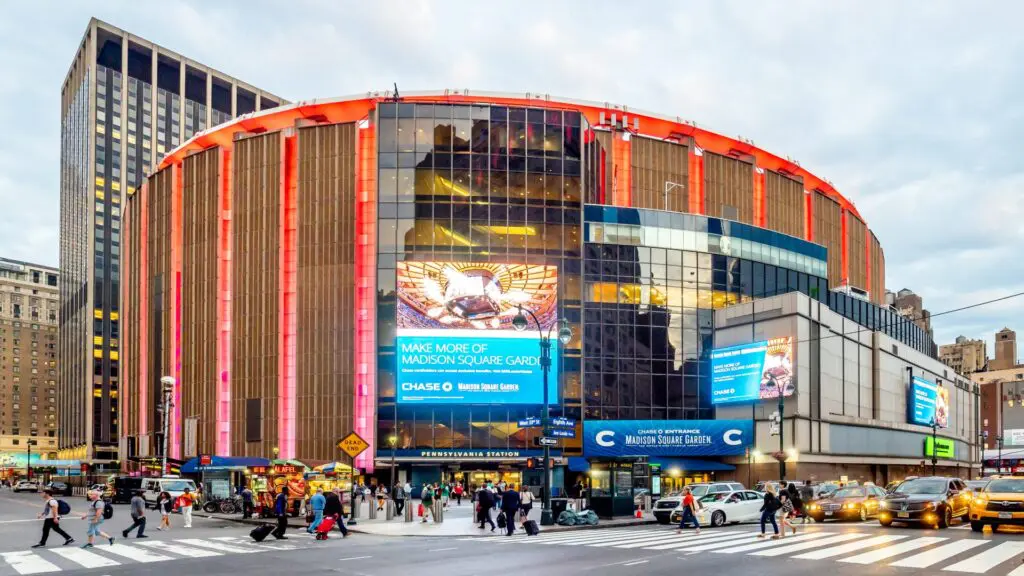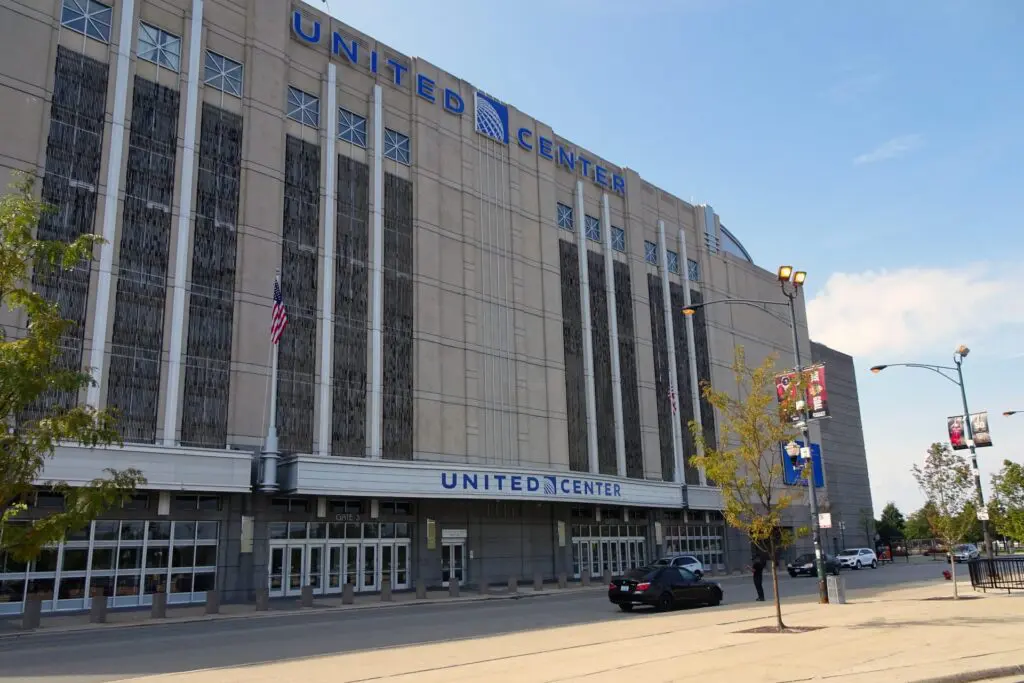Best Basketball Arenas in the World
Although basketball arenas are most often associated with arenas in the NBA, recently renovated and constructed basketball arenas in Canada, Europe, China, and Africa have made even the most glamorous NBA ones blush.
Featuring modern architecture, spacious seating, and world-class concession items and options, basketball arenas across the world have upped their offerings in an effort to attract fans and players.
Not withstanding, many NBA arenas continue to be the Mecca for basketball players and fans alike.
Below, we are going to review the best basketball arenas in the world and discuss the various offerings, seating capacities, and renovations completed on the arena to help continue to attract both players and fans.
Madison Square Garden

Whether you’re an avid basketball fan or a casual one, Madison Square Garden, or more colloquially referred to as The Garden or simply MSF, is a multipurpose indoor arena in the heart of New York City.
Longtime arena for the NBA’s New York Knicks, Madison Square Garden is conveniently located between Seventh and Eight avenues from 31st to 33rd Street in Manhattan.
Located directly above Pennsylvania Station, Madison Square Garden is an iconic landmark in New York City and comparable to other midtown Manhattan buildings, including the Empire State Building, Koreatown, and Macy’s at Herald Square.
Opened on February 11, 1968, Madison Square Garden is the oldest major sporting facility in the New York metropolitan area and the oldest arena in both the NBA and the NHL.
And with a total construction and renovation cost of over $1.1 billion, it has been ranked as one of the 10 most expensive stadiums and arenas ever built.
TD Garden

Home to one of the NBA’s most celebrated teams, the Boston Celtics, TD Garden is comparable in esteem to Madison Square Garden and iconic in both its history and floor design.
A multi-purpose arena in the heart of Boston, Massachusetts, it is named after it long-time sponsor TD Bank. And located directly above the MBTA’s North Station, TD Garden is easily accessible by subway, foot, drive, or via a taxi-cab.
And in addition to being the home of the NBA’s Boston Celtics, TD garden is also the home arena for the NHL’s Boston Bruins.
Similarly, TD Garden hosts multiple NCAA Division I Men’s and Women’s Basketball Tournament games and serves as a concert venue for a slew of numerous nationally touring music and comedic acts.

However, TD Garden may be most famous for its parquet flooring.
The parquet flooring look was actually the product of a lumber shortage in 1946, just as the Boston Celtics were about to debut in the Basketball Association of America (BAA).
Due to the aftermath of World War II, many common, household items were in short supply. This included professionally cut wood. And with much of the manufactured wood earmarked for residential homes for servicemen who returned from the war, the Celtics were in dire straits.
Rather than postpone the opening and ceremonial season, Walter Brown, the original owner of the Boston Celtics, opted to get scraps of wood from local lumber yards throughout the Boston area.
As Jeff Twiss, the Celtics vice president of media services and alumni relations would recount:
“What Walter Brown, the original owner of the Celtics, did in order to I guess attract fans and attract good players maybe back then — an early selling point — was to get a good, quality floor made…The only way they could do that was getting scraps of wood at lumber yards throughout Boston and put together a floor. And it just happened to be in patterns that formed a parquet-type of a design.”
And, interestingly enough, the original basketball court was constructed for just $11,000. The pieces were laid out in an alternating pattern and there was a total of 247 5-foot by 5-foot square panels held together by wood planks, brass screws, and 988 bolts.
And although the newly designed and built TD Garden did not have those same lumber shortages, as an homage to the team’s history, the parquet floor design was continued.
Crypto.com Arena

Perhaps better known as its former name as the Staples Center, Crypto.com Arena is another magnificent multipurpose arena. Located in Downtown Los Angeles, the arena is adjacent to the famous Los Angeles Convention Center.
Owned and operated by the Arturo L.A. Arena Company and Anschutz Entertainment Group. The Crypto.com Arena is home venue to the Los Angeles Kings of the National Hockey League (NHL), the Los Angeles Lakers and the Los Angeles Clippers of the National Basketball Association (NBA), and the Los Angeles Sparks of the Women’s National Basketball Association (WNBA).
Hosting over 250 events annually, Crypto.com Arena is one of the most popular and widely used arenas in the United States and welcomes over 4 millions guests each year.
Crypto.com Arena is commonly referred to as the “deal that almost wasn’t” due to the sheer amount of backlash, criticism to the project, and differences between real estate developers and city planners.
However, ground broke in 1997 and the arena was completed and opened 2-years later.
At a cost of $375 million of private financing, the arena would become one of the cultural landmarks and icons of the greater Los Angeles area and has been a tourist destination since it opened.
Barclays Center

We’ll probably face some backlash for this choice but the recently constructed Barclays Center makes it to our list of one of the best basketball arenas in the world due to its sheer size and imprint on the Brooklyn landscape.
A beautiful and modern arena, Barclays Center is home to the Brooklyn Nets, who moved from Newark, New Jersey to their new location in Brooklyn.
In addition to hosting the Brooklyn Nets, Barclays Center is the home of the WNBA’s New York Liberty and hosts concerts, conventions, and other sporting and entertainment events throughout the year.
The arena is a part of a $4.9 billion future business and residential complex now known as Pacific Park. Barclays Center is at Atlantic Avenue, next to the renamed Atlantic Avenue–Barclays Center subway station on the 2, 3, 4, 5, B, D, N, Q, R and W routes, as well as directly above the LIRR’s Atlantic Terminal, making it one of the easiest accessible arenas in the United States.
Strategically proposed and planned by Bruce Ratner, who purchased the Nets for $300 million, Ratner’s original plan of moving the Nets to Brooklyn and to the Barclays Center was done in an effort to attract individuals to the Atlantic Yards, an extensive redevelopment project being constructed by Ratner’s real estate development company.
United Center

A monolithic of a building, the United Center is located on the Near West Side of Chicago, Illinois and is the current home of both the NBA’s Chicago Bulls and the NHL’s Chicago Blackhawks.
Named after corporate sponsor United Airlines, who are based in Chicago, the United Center has a capacity of over 21,000 and is the largest arena by capacity in the league.
140-feet tall and at a cost of $175 million, the United Center is built from concrete and over 3,500 tons of steel. Opened in 1994, the United Center replaced the Chicago Stadium, which is located across the street.

And, for fans of basketball, the United Center is home to the legendary and iconic statue of Michael Jordan.
FTX Arena

Formerly and commonly referred to as the American Airlines Arena, FTX Arena is located in beautiful Miami, Florida, alongside the Biscayne Bay. Constructed in 1998, the FTX Arena was built to replace the aging Miami Arena.
Home to the NBA’s Miami Heat, FTX Arena is directly served by the Miami Metrorail at Government Center station via free transfers to Metromover Omni Loop, providing direct service to Freedom Tower and Park West stations.
Similarly, FTX Arena is also within walking distance from the Historic Overtown/Lyric Theatre Metrorail station.
A luxurious, beautiful, and modern basketball arena, FTX Arena has 2,105 club seats, 80 luxury suites, and 76 private boxes. And with a capacity of over 19,600, it is one of the larger NBA arenas.
Opened on December 31, 1999, the original construction cost was in excess of $213 million.
O.A.C.A. Olympic Indoor Hall

O.A.C.A. Olympic Indoor Hall, which is honorarily named Nikos Galis Olympic Indoor Hall is a part of the Olympic Athletic Center of Athens and was constructed and built in 1995.
Located in Marousi, Athens, the O.A.C.A Olympic Indoor Hall was the largest indoor venue used for sporting events in the 2004 Summer Olympics in Athens, Greece.
Considered to be one of the biggest and most modern indoor sports arenas in all of Europes, it has a seating capacity of over 19,250 and also contains an indoor training facility.
In recent years, The Indoor Hall is the regular home court for the Greek Basket League professional basketball club Panathinaikos. It is also the primary home court of the senior Greek National Basketball Team.
Štark Arena

Commonly referred to as Belgrade Arena, the multipurpose indoor arena is located in Belgrade, Serbia and was designed as a universal hall for sports, cultural events, and other entertainment programs.
Capable of housing over 18,000 spectators, the arena is massive and has caused substantial real estate price increases to the local residential and commercial properties.
Beijing National Indoor Stadium

An indoor basketball and multi-use stadium located in the Olympic Green in Beijing, China, the Beijing National Indoor Stadium has a total capacity of over 20,000 and was originally constructed for use at the 2008 Summer Olympics in Beijing.
Nicknamed “the Fan” due to its design resembling a traditional Chinese folding fan, the stadium has been used for a variety of sports since it opened, including basketball, hockey, gymnastics, and handball.
Cairo Stadium Indoor Halls Complex

Cairo Stadium Indoor Halls Complex consists of four Olympic-standard, multi-use indoor sporting arenas located near the Cairo International Stadium in Cairo, Egypt. The seating capacity of The Main Hall, which is primarily used for sports, is 16,900 spectators.
One of the largest sports complex’s and arenas in Africa and the Middle East, the Cairo Stadium indoor Halls Complex was completed construction in September 1991 and has been used for a variety of sporting events, including basketball, volleyball, and badminton.
